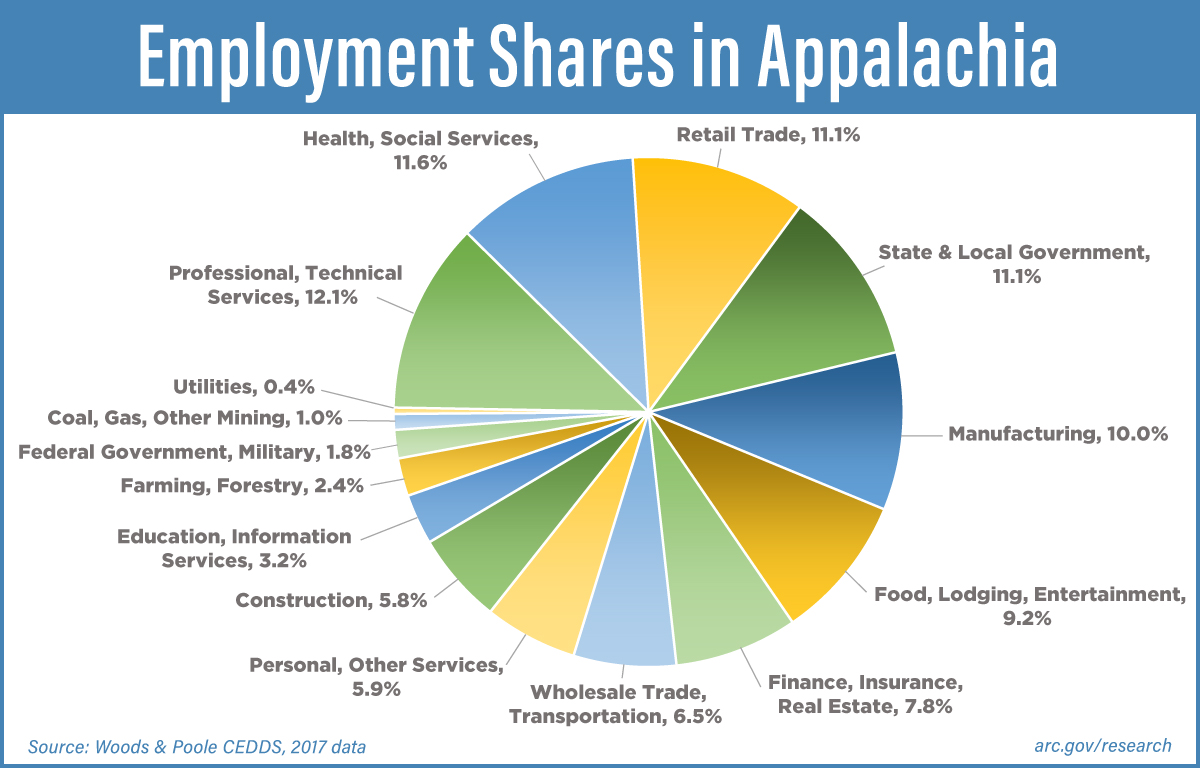WASHINGTON, D.C., November 13, 2019—Today, the Appalachian Regional Commission (ARC) released Industrial Make-Up of the Appalachian Region, a new report examining employment and earnings across the Region. Drawing on data from 15 industry sectors, the report catalogues how the Region’s industrial make-up and earnings compare to that of the country as a whole. The report primarily focuses on the period from 2002–2017—the years immediately before, during, and after the Great Recession—and finds that employment growth varies across the Region. Overall, while post-Recession employment growth has been positive in Appalachia, it lags behind the growth that was experienced by the country as a whole. The report also finds an overall employment shift across the Region towards professional & technical services; health & social services; and tourism-related jobs.
“Good data yields good policy, and I am pleased our Research and Evaluation team has detailed the economic picture over a critical 15-year period of change and growth for Appalachia, when economic challenges have significantly impacted both the nation and our Region specifically,“ said ARC Federal Co-Chairman Tim Thomas. “Understanding where we are seeing growth and in which sectors helps guide our investments toward a resilient and strong Appalachian economy.”
Among the Report’s key findings:
-
- From 2012 to 2017, employment across all industries in Appalachia grew 4.7 percent. Growth was positive, yet lagged behind the country as a whole which grew 9.6 percent during the same time period.
-
- From 2012 to 2017, the fastest growth in employment occurred in Appalachia’s South Central and Southern subregions, at 6.6 percent and 10.4 percent, respectively.
-
-
- The Appalachian counties in Alabama, Georgia, and South Carolina saw faster growth in employment than in the states’ respective non-Appalachian counties.
-
-
-
- The Appalachian counties in Kentucky, New York, and Virginia all experienced declines in employment, compared to the positive employment growth that took place in these states’ non-Appalachian counties. In both Appalachian Kentucky and Appalachian Virginia, employment in the coal, gas, and other mining industry experienced large declines from 2012 to 2017: 37 percent and 38 percent, respectively.
-
-
- In 2017, the five industries with the largest employment shares in the Region were professional & technical services (12.1 percent), health and social services (11.6 percent), retail and trade (11.1 percent); state and local government (11.1 percent); and manufacturing (10 percent).
-
- In 2017, 10 percent of Appalachia’s total employment was in the manufacturing industry, a larger share than the country as a whole (6.8 percent).
-
- In 2017, 11.6 percent of Appalachia’s total employment was in the health & social services sector, compared with 11.3 percent for the United States as a whole. Additionally, 9.2 percent of the Region’s employment belonged to the food, lodging, and entertainment industry, comparable to the 9.8 percent found at the national level.
- Together, finance, insurance & real estate; food, lodging, and entertainment; health and social services; manufacturing; professional and technical services; retail trade; state and local government; and wholesale trade and transportation make up roughly 75 percent of the Region’s employment share.
The full report, as well as links to state-by-state fact sheets indicating largest employment shares and fastest growth in employment by sector for each of Appalachia’s 13 states, is available at www.arc.gov/research.
About the Appalachian Regional Commission
The Appalachian Regional Commission (www.arc.gov) is an economic development agency of the federal government and 13 state governments focusing on 420 counties across the Appalachian Region. ARC’s mission is to innovate, partner, and invest to build community capacity and strengthen economic growth in Appalachia to help the Region achieve socioeconomic parity with the nation.
